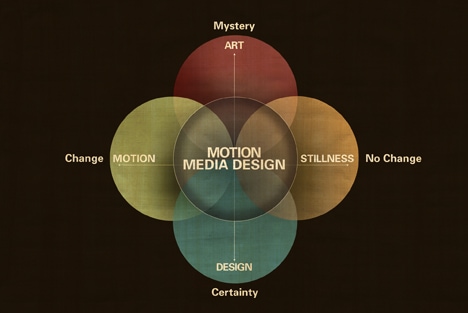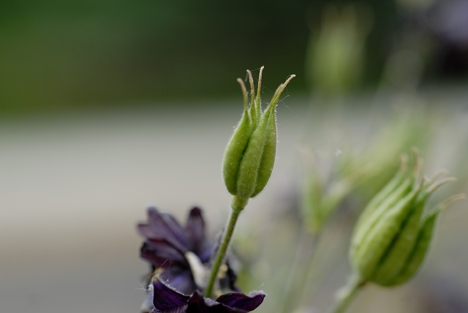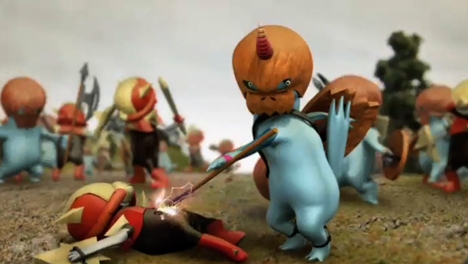Editor’s Note: The Big Think Series attempts to step back from our frame-to-frame existence and look at the bigger picture. This post is from Austin Shaw, a designer and director currently serving as a Professor of Motion Media Design at the Savannah College of Art & Design.

Motion Media Design Fractal © Austin Shaw 2010
This is a question that many Motion Media Designers struggle to answer. Is it Motion Graphics? Is it Animation? Is it Branding? The Theory presented in the fractal diagram above seeks to answer some of these questions.
Motion Media Design builds on the tradition of many creative disciplines. To break it down to its essence, I have constructed a fractal image that is essentially a set of cross continuums. Each continuum represents a pair of complementary opposites. Being complementary means that each opposing end of a continuum completes and/or balances its opposite. That means that an aspect of Motion Media Design such as “Motion” is not complete without its complementary opposite, “Stillness.”
This theory is expressed through the idea that a beautiful motion piece begins with a beautiful still image. A single Style Frame is most often the genesis of a Motion Design piece. In practice, I typically begin a Design Board striving to achieve a frame with a dynamic composition. Once I have a great composition, I will create another frame in the sequence, either before or after my first ‘Hero’ frame. Creating beautiful motion becomes an extension of creating beautiful compositions in still frames. The process of animating can be a journey from one amazing composition to the next as planned out in a Design Board.
If you look at the fractal diagram you will see the words “Change” and “No Change” at either end of the Motion / Stillness continuum. These serve as tipping point guidelines to know where a piece stands along the continuum. The question to ask to determine where a piece is located along the continuum is “Is it changing?.” If it is changing then it is tipping towards Motion. Conversely, if it is not changing then it is tipping towards Stillness. Let’s have a look at an example of each…
Motion
Now take a moment. Reflect on what you just experienced. Then take a look at an example of Stillness…
Stillness

"Still Life"
To be clear, I am not placing a value judgment on either Motion or Stillness. Rather, I am attempting to highlight their differences as to better understand their respective strengths. In the Panda Panther piece, I am amazed at the richness of Change. The music and sound design creates movement through emotion. The camera angle is constantly changing from wide to medium to tight shots. The point of view of the beings of the opposing armies changes as they exchange masks, not to mention our view of these beings as semi-savage warlike critters, to cute and childlike characters. Change can be experienced both externally in what we see, and internally in how we perceive and feel.
Now, contrast the experience of ‘Masks’ with the still life of the flower. Silent and calm is what I feel, especially heightened immediately following the viewing of the Motion piece. There is a serenity rooted in the Stillness, a theoretical snapshot of a moment in time. Both pieces may share many similar qualities, but there are fundamental differences.
It is important to note that the notions of absolute Motion or absolute Stillness exists only in theory. You will indeed find moments of Stillness in Motion as well as Motion in Stillness. However, the overall quality of a piece will tip towards one end of the continuum or the other.
I am curious to hear your responses to the experience of Motion compared to Stillness.
To be continued in Part 2: Art & Design


No comments:
Post a Comment